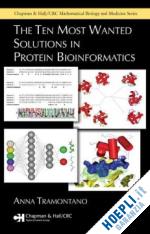
-
DISPONIBILITÀ IMMEDIATA
{{/disponibilitaBox}}
-
{{speseGratisLibroBox}}
{{/noEbook}}
{{^noEbook}}
-
Libro
-
-
SPEDIZIONE GRATUITA
- Genere: Libro
- Lingua: Inglese
- Editore: Chapman and Hall/CRC
- Pubblicazione: 05/2005
- Edizione: 1° edizione
The Ten Most Wanted Solutions in Protein Bioinformatics
tramontano anna
136,98 €
130,13 €
{{{disponibilita}}}
Disponibilità Normalmente disponibile in 20 giorni
TRAMA
Exploring high speed computational methods to extrapolate to the rest of the protein universe, The Ten Most Wanted Solutions in Protein Bioinformatics considers the most significant problems occupying those looking to identify the biological properties and functional roles of proteins. After summarizing each problem, the author looks at and evaluates the current approaches being utilized, before going on to consider some potential approaches and future possibilities. The author also presents introductory material on protein structure and function, with an evolutionary perspective and includes a suggested reading list for further research at the end of each chapterNOTE EDITORE
Utilizing high speed computational methods to extrapolate to the rest of the protein universe, the knowledge accumulated on a subset of examples, protein bioinformatics seeks to accomplish what was impossible before its invention, namely the assignment of functions or functional hypotheses for all known proteins.The Ten Most Wanted Solutions in Protein Bioinformatics considers the ten most significant problems occupying those looking to identify the biological properties and functional roles of proteins.- Problem One considers the challenge involved with detecting the existence of an evolutionary relationship between proteins. - Two and Three studies the detection of local similarities between protein sequences and analysis in order to determine functional assignment. - Four, Five, and Six look at how the knowledge of the three-dimensional structures of proteins can be experimentally determined or inferred, and then exploited to understand the role of a protein. - Seven and Eight explore how proteins interact with each other and with ligands, both physically and logically. - Nine moves us out of the realm of observation to discuss the possibility of designing completely new proteins tailored to specific tasks. - And lastly, Problem Ten considers ways to modify the functional properties of proteins.After summarizing each problem, the author looks at and evaluates the current approaches being utilized, before going on to consider some potential approaches.SOMMARIO
Problem 1 Protein Sequence AlignmentIntroduction to the Problem, The Evolution of Proteins (Evolution-Based Inference of Protein Function, Orthology and Paralogy, Protein Families, Similarity Matrices, Indel Penalties, Local versus Global Alignment), How Do We Align Sequences? (Global Alignment of Two Protein Sequences:, The Needleman and Wunsch Algorithm, Local Alignment of Two Protein Sequences:, The Smith and Waterman Algorithm, Multiple-Sequence Alignments, Profiles, Hidden Markov Models, Database Searching), Reliability of Present Methods and Promising Avenues, Suggested Reading Problem 2 Predicting Protein Features from the SequenceIntroduction to the Problem, Deterministic Patterns, Stochastic Patterns, Specificity and Sensitivity of a Feature Prediction (The ROC Curve), The Prediction of Protein Domain Boundaries, Reliability of Present Methods and Promising Avenues, Suggested ReadingProblem 3 Function PredictionIntroduction to the Problem, The Definition of Biological Function, The Function Vocabulary, Protein Names, Text Mining, Transferring Functional Annotations by Similarity, Transcriptomics, Proteomics, Promising Avenues, Suggested ReadingProblem 4 Protein Structure PredictionIntroduction to the Problem, Energetic Calculations of Protein Structures (Energy Calculation, Molecular Mechanics, Potentials of Mean Force), Searching the Protein Conformational Space (Molecular Dynamics, Monte Carlo Methods, Simulated Annealing, Genetic Algorithms), Knowledge-Based Methods, Evolution-Based Methods, Fold Recognition, Fragment-Based Methods, Natively Unfolded Proteins, Promising Avenues, Suggested ReadingProblem 5 Membrane ProteinsIntroduction to the Problem, The Structure of the Membrane, The Structure of Membrane Proteins, Prediction of the Structure of Membrane Proteins, Prediction of the Topography of Membrane Proteins, Prediction of the Topology of Membrane Proteins, Prediction of the Three-Dimensional Structure of, Membrane Proteins, Promising Avenues, Suggested ReadingProblem 6 Functional Site Identification Introduction to the Problem, Structural Genomics, Structural Superposition (Root Mean Square Deviation, Structural Superposition between Two Different, Proteins, Distance Matrices), Structural Classification of Proteins, Detecting the Active Site, Moonlight Proteins, Promising Avenues, Suggested Reading , Problem 7 Protein-Protein Interaction Introduction to the Problem, Protein Interactions, Sequence-Based Methods for Predicting Interactions, Experimental Methods for Detecting Protein-Protein, Interactions, Structure-Based Methods for Predicting Interactions, Representation of Protein Structures for Docking (Computational Approaches to Include Protein, Flexibility in Docking Procedures, Searching Conformational Space for Docking, Scoring Docking Solutions), The CAPRI Experiment, Promising Avenues, Suggested ReadingProblem 8 Protein-Small Molecule Interaction Introduction to the Problem, Search Strategies and Scoring Functions, Fragment-Based and Point-Complementarity Methods, Distance Geometry-Based Methods, Virtual Screening, The Properties of a Drug, Promising Avenues, Suggested ReadingProblem 9 Protein DesignIntroduction to the Problem, Intuitive Design, Lattice Models and Automatic Methods, Promising Avenues, Suggested ReadingProblem 10 Protein EngineeringIntroduction to the Problem, Combining Functions, Global Properties, Active and Binding Sites, Catalytic Antibodies, Combinatorial Design, Dissecting the Folding Pathway of Proteins, Promising Avenues, Suggested Reading ConclusionsIndexAUTORE
Anna TramontanoALTRE INFORMAZIONI
- Condizione: Nuovo
- ISBN: 9781584884910
- Collana: Chapman & Hall/CRC Computational Biology Series
- Dimensioni: 9 x 6 in Ø 1.01 lb
- Formato: Copertina rigida
- Illustration Notes: 80 b/w images, 24 color images, 10 tables and 15 halftones
- Pagine Arabe: 218
